Beetroot and Goat’s Cheese Tart
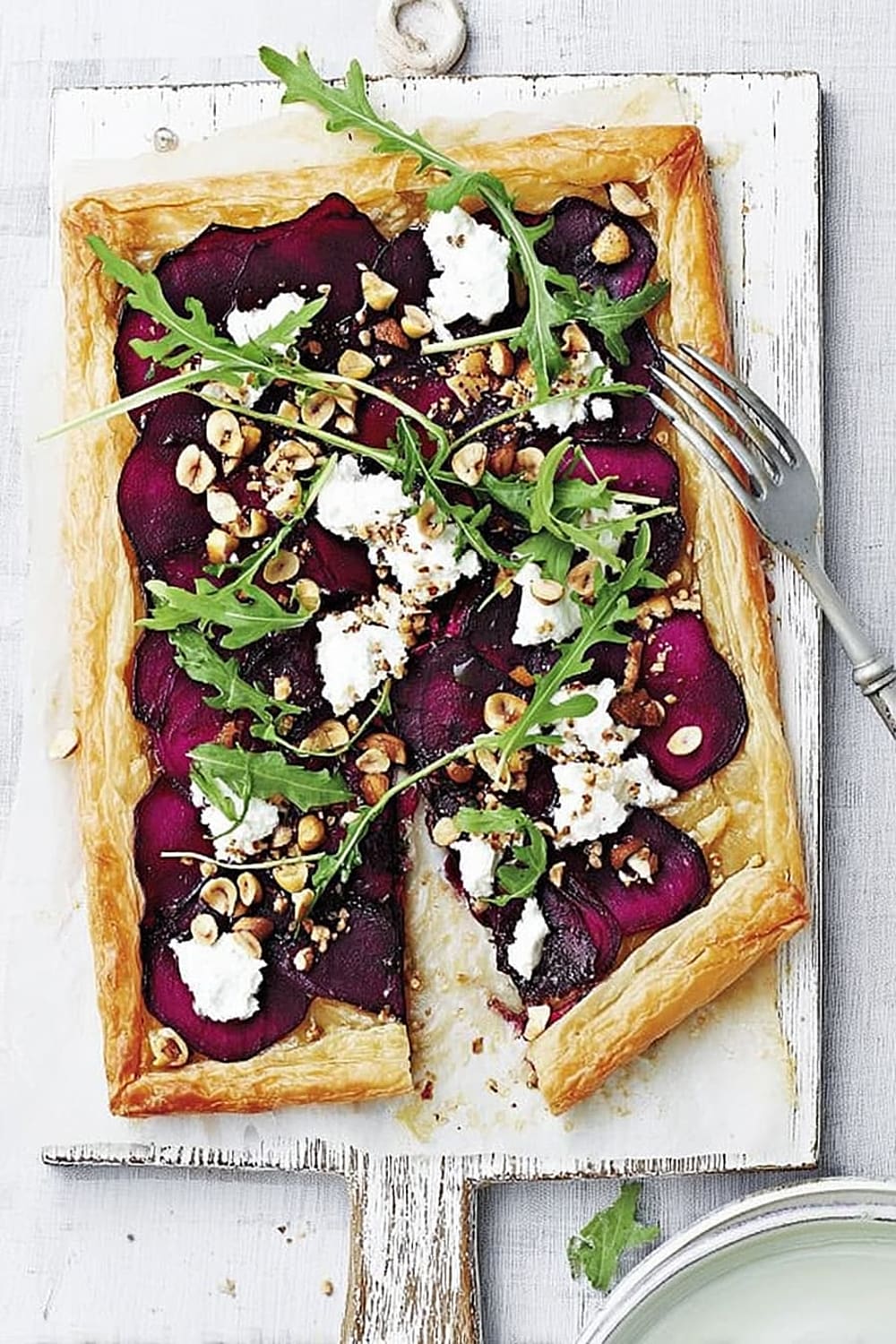
This beetroot and goat’s cheese tart is basically the sophisticated cousin of your average vegetable dish that somehow makes everyone think you’ve got your culinary life completely sorted out.
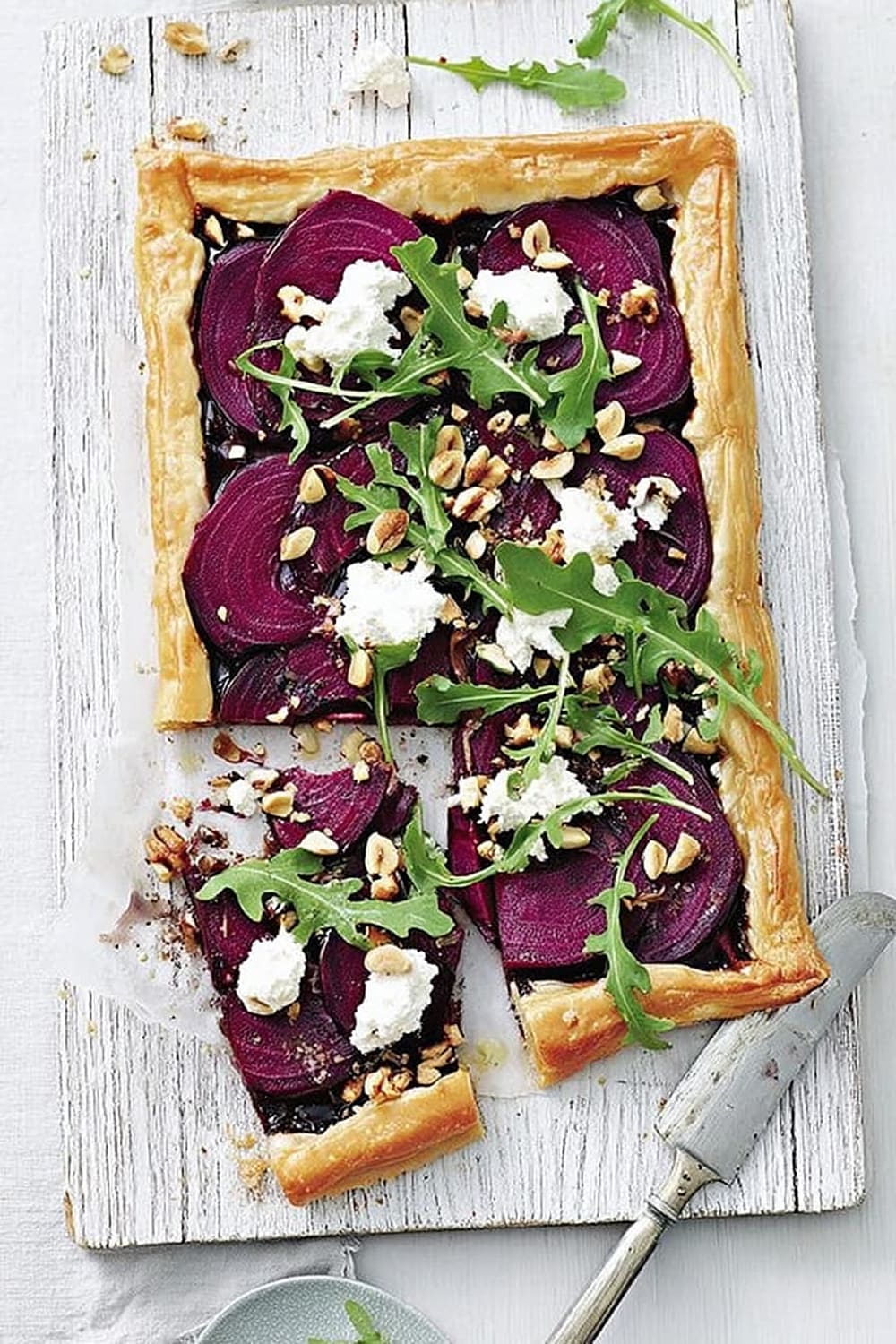
The combination of honey-roasted beetroot with creamy goat’s cheese creates this incredible sweet-savory balance that’ll have people asking for the recipe before they’ve even finished their first slice.
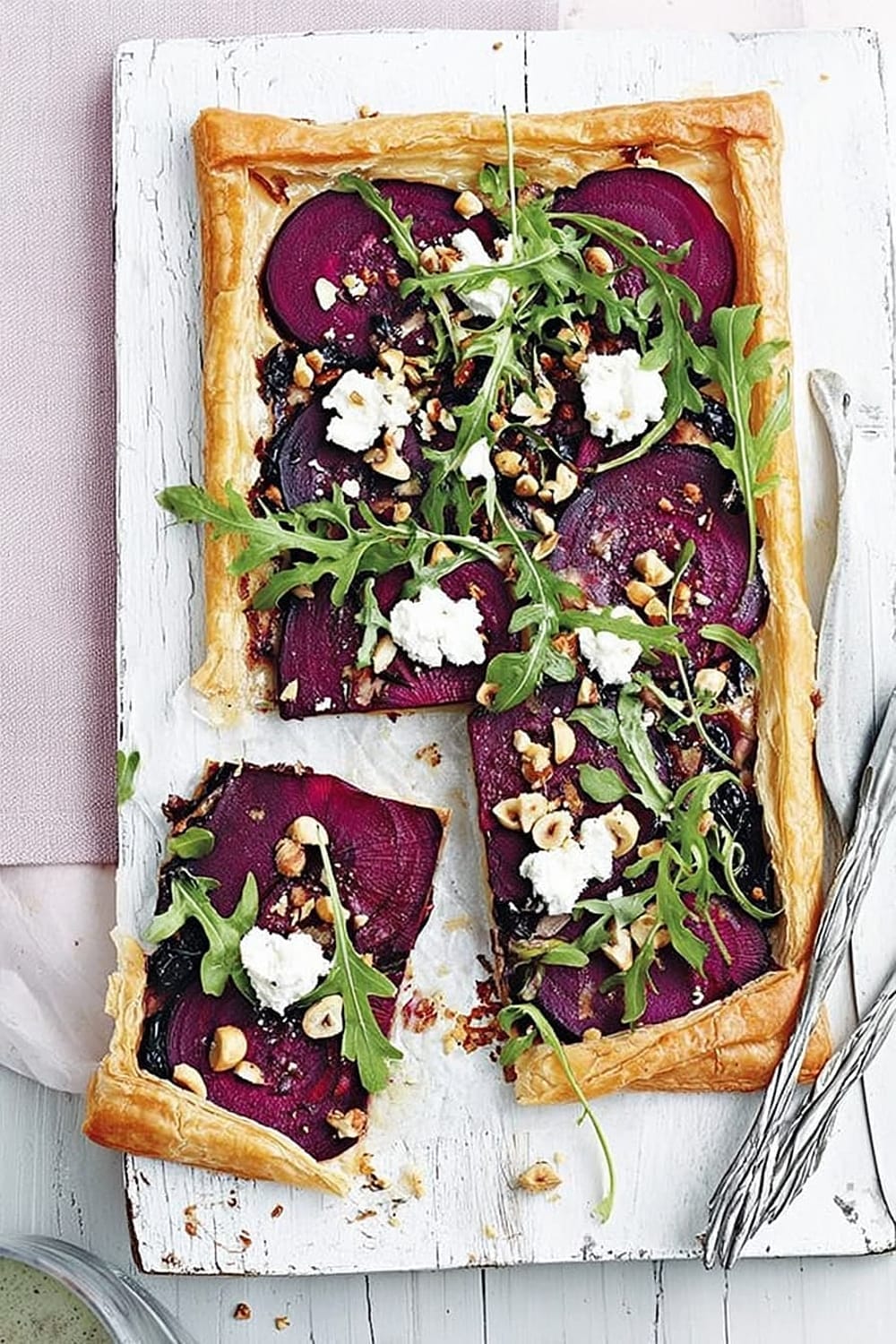
What makes this tart absolutely genius is how the puff pastry does all the heavy lifting while you just arrange beautiful ingredients on top like some kind of pastry artist.
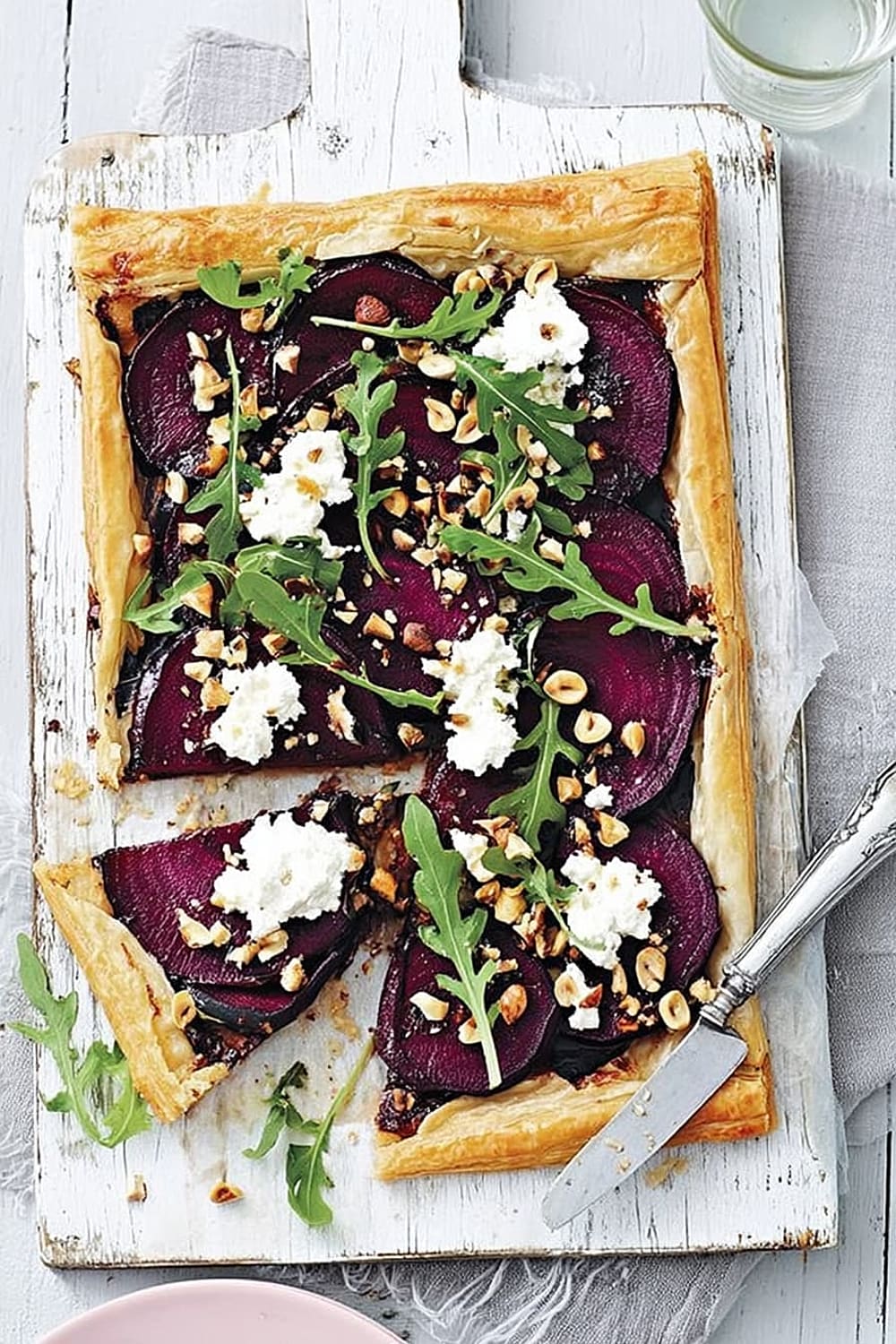
The earthy sweetness of the beetroot gets intensified by the honey and orange juice, creating these gorgeous caramelized edges that look like you spent hours perfecting them.
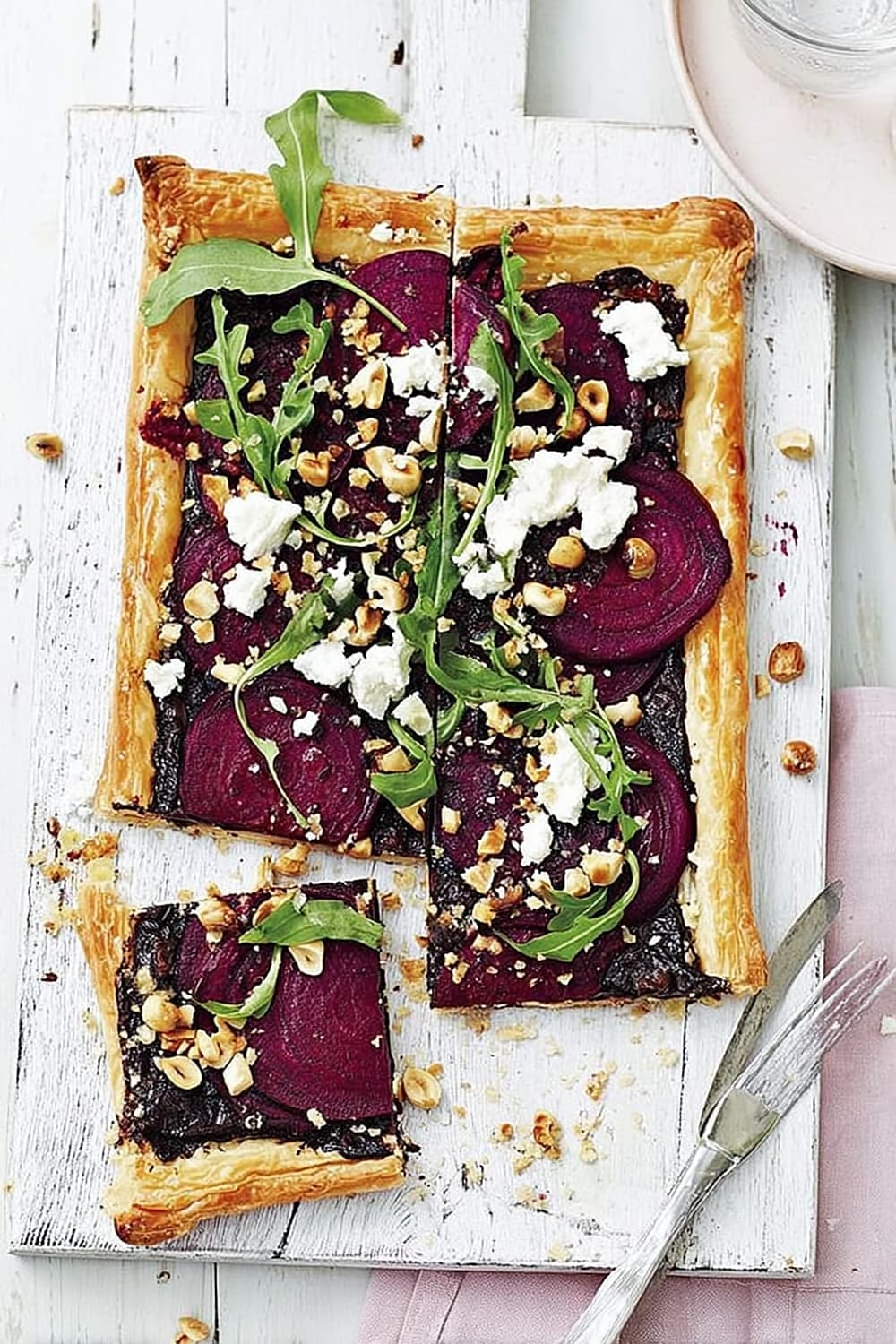
Those crunchy hazelnuts scattered on top add the perfect textural contrast to the creamy goat’s cheese and tender beetroot, making every bite interesting.
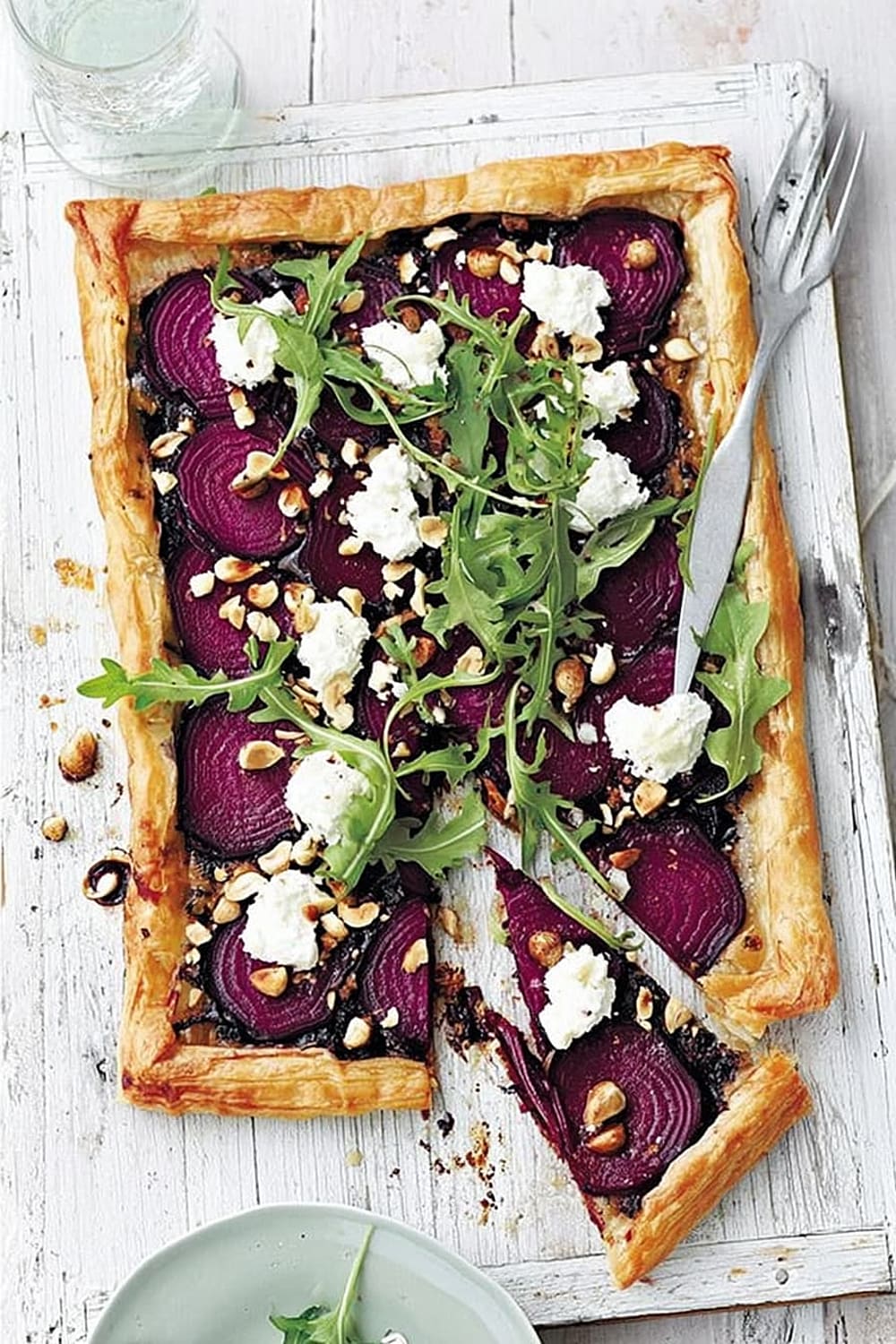
This is the kind of recipe that transforms a simple weeknight dinner into something that feels special enough for company, even if you’re just treating yourself.
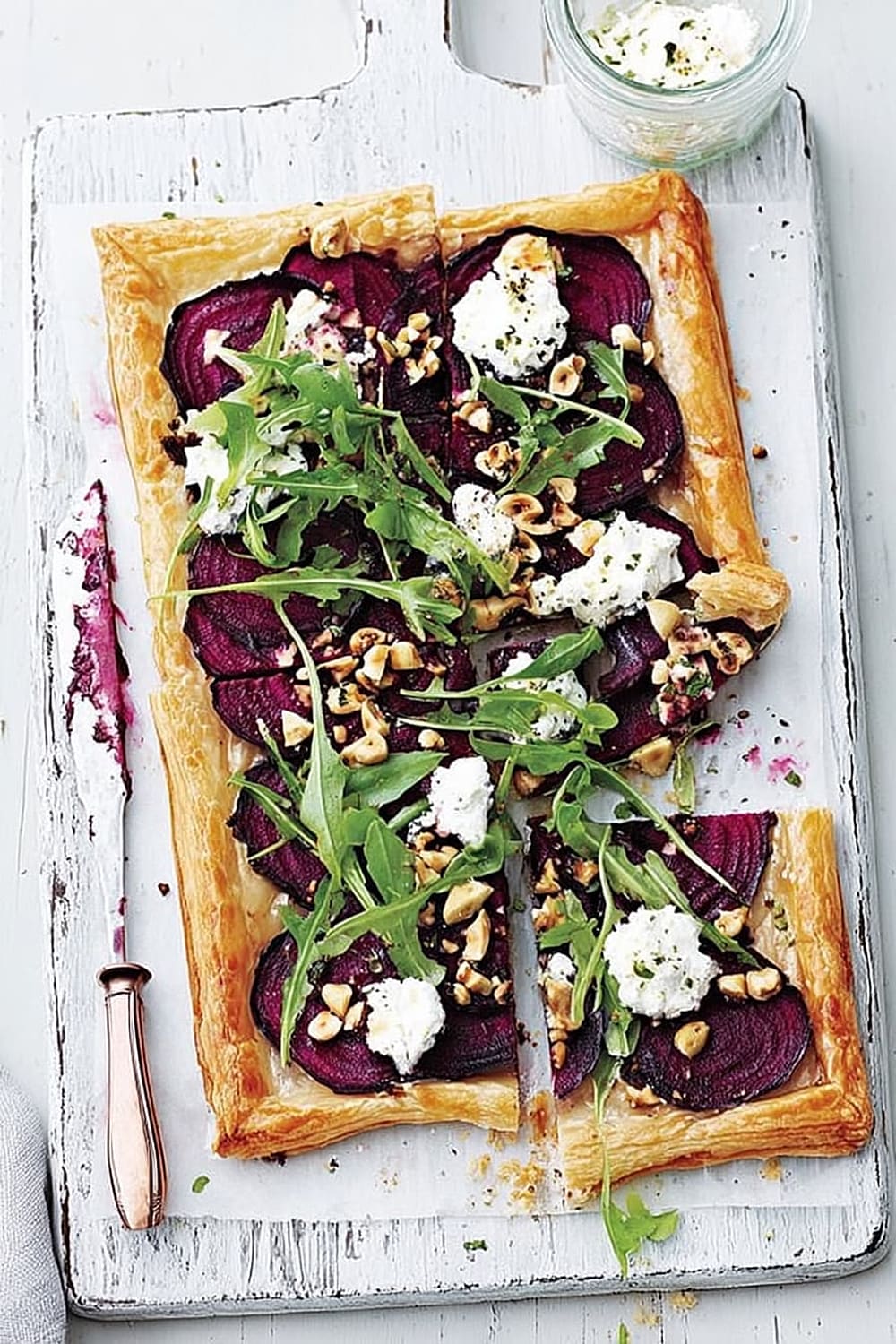
Ingredients
For the roasted beetroot
- 500 g bunch raw beetroot
- 100 ml clear honey
- 2 tsp olive oil
- Squeeze of orange juice
For the tart base
- 320 g puff pastry sheet
For the topping
- 15 g shelled hazelnuts
- 25 g soft vegetarian goat’s cheese
- Rocket to serve (optional)
Instructions
Preparation
- 1 Heat the oven to 200°C/fan 180°C/gas 6 and line a roasting tin with aluminum foil. This dual-temperature approach ensures even cooking for both the beetroot and pastry components.
- 2 Peel the beetroot using a sharp knife or vegetable peeler, then finely slice into 3-4mm thick rounds. Consistent thickness is crucial for even roasting and prevents some pieces from burning while others remain undercooked.
- 3 Layer the beetroot slices evenly in the foil-lined roasting tin, ensuring they don’t overlap too much. Drizzle with the honey, olive oil, and orange juice, making sure each slice gets some of the sweet glaze.
Roasting the beetroot
- 4 Cover the beetroot tightly with foil and roast for 25 minutes or until tender when pierced with a fork. The foil creates a steam environment that helps the beetroot cook evenly while the honey caramelizes.
Preparing the pastry
- 5 Meanwhile, place the puff pastry on a baking sheet and prick all over with a fork at 1cm intervals. This prevents the pastry from puffing up too much and creates a stable base for the toppings.
- 6 Bake the pastry on the shelf below the beetroot for 20 minutes until golden and crisp. The lower rack position prevents the top from browning too quickly.
Assembly and final baking
- 7 Remove both the beetroot and pastry from the oven. Take off the foil from the beetroot and place another baking sheet on top of the pastry to gently flatten it, creating an even surface.
- 8 Using a fish slice or wide spatula, carefully transfer the roasted beetroot onto the pastry base, leaving a 2cm border around the edges. This border prevents the filling from spilling over and allows the pastry edges to crisp up beautifully.
- 9 Drizzle any remaining honey juices from the roasting tin over the beetroot. Roughly chop the hazelnuts and crumble the goat’s cheese, then scatter both evenly over the tart.
- 10 Return to the oven for 10 minutes until the goat’s cheese is slightly golden and the pastry edges are deep golden brown. Serve immediately, scattered with fresh rocket if desired.
Recommended Equipment and Kitchen Tools
Recommended Tools (for best results)
- Sharp knife or mandoline slicer – Essential for achieving uniform beetroot slices that cook evenly and look professional
- Large roasting tin – Provides enough space for beetroot to roast without overcrowding, ensuring proper caramelization
- Aluminum foil – Creates the perfect steam environment for tender beetroot while preventing burning
- Fish slice or wide spatula – Makes transferring delicate roasted beetroot slices much easier without breaking them
Helpful Upgrades
- Parchment paper – Can be used under the pastry for easier removal and cleanup
- Digital kitchen scale – Ensures accurate measurements, especially important for the pastry-to-topping ratio
- Pastry brush – Useful for evenly distributing the honey glaze if you prefer more control
Nice-to-Have Options
- Silicone baking mat – Provides excellent non-stick surface for the pastry base
- Microplane grater – Perfect for adding fresh orange zest to enhance the citrus notes in the glaze
Recipe Variations and Dietary Modifications
Gluten-Free Adaptation
- Replace puff pastry with gluten-free puff pastry (available from most supermarkets)
- Ensure all other ingredients are certified gluten-free, particularly checking the goat’s cheese packaging
- Gluten-free pastry may need an extra 2-3 minutes baking time to achieve the same golden color
Dairy-Free Modifications
- Substitute goat’s cheese with cashew cream cheese or dairy-free feta alternative
- Use vegan puff pastry (check ingredients as some contain butter)
- The creamy texture will be slightly different but equally delicious
Vegan Version
- Replace goat’s cheese with nutritional yeast mixed with cashew cream for a cheesy flavor
- Use vegan puff pastry made with plant-based fats
- Add toasted pine nuts for extra richness and protein
Flavor Variations
- Mediterranean style: Add sun-dried tomatoes and fresh thyme alongside the beetroot
- Autumn harvest: Include roasted butternut squash and toasted walnuts instead of hazelnuts
- Herbed version: Mix fresh rosemary or sage into the honey glaze for aromatic depth
Nutritional Information and Health Benefits
Key Nutritional Highlights
This tart provides approximately 285 calories per serving with a balanced mix of complex carbohydrates from the beetroot, healthy fats from nuts and cheese, and moderate protein content. Each serving contains roughly 8g protein, 18g carbohydrates, and 20g fat, making it a satisfying meal that provides sustained energy.
Health Benefits of Main Ingredients
Beetroot is packed with nitrates that support cardiovascular health and may help lower blood pressure. It’s also rich in folate, manganese, and betalains – powerful antioxidants that give beetroot its vibrant color and provide anti-inflammatory benefits. The fiber content supports digestive health and helps regulate blood sugar levels.
Goat’s cheese offers high-quality protein and calcium while being easier to digest than cow’s milk cheese due to its different protein structure. Hazelnuts contribute vitamin E, healthy monounsaturated fats, and magnesium, supporting heart health and providing sustained energy.
Dietary Considerations
This recipe contains gluten (from puff pastry) and dairy (from goat’s cheese). It’s naturally vegetarian and provides good amounts of folate and antioxidants. The honey provides natural sweetness but does add sugar content, making portion control important for those monitoring blood sugar levels.
Smart Swaps and Ingredient Substitutions
Common Substitutions:
- Beetroot → Roasted butternut squash or sweet potato (same cooking time and method)
- Goat’s cheese → Feta cheese or ricotta cheese for different flavor profiles
- Hazelnuts → Toasted pine nuts, chopped walnuts, or pumpkin seeds for varied textures
- Honey → Maple syrup or agave nectar in equal amounts
Budget-Friendly Swaps:
- Puff pastry → Homemade shortcrust pastry (more economical and equally delicious)
- Goat’s cheese → Cream cheese mixed with herbs for a similar creamy texture
- Hazelnuts → Sunflower seeds or chopped almonds for affordable crunch
Pantry Emergency Substitutions:
- Fresh beetroot → Pre-cooked vacuum-packed beetroot (reduce roasting time to 10 minutes)
- Orange juice → Lemon juice or balsamic vinegar for acidity
- Rocket → Baby spinach or watercress for peppery greens
Pro Tips for Substitutions:
- When using different root vegetables, adjust cooking times based on density – sweet potato cooks faster than beetroot
- Store leftover goat’s cheese wrapped in parchment paper in the refrigerator for up to one week
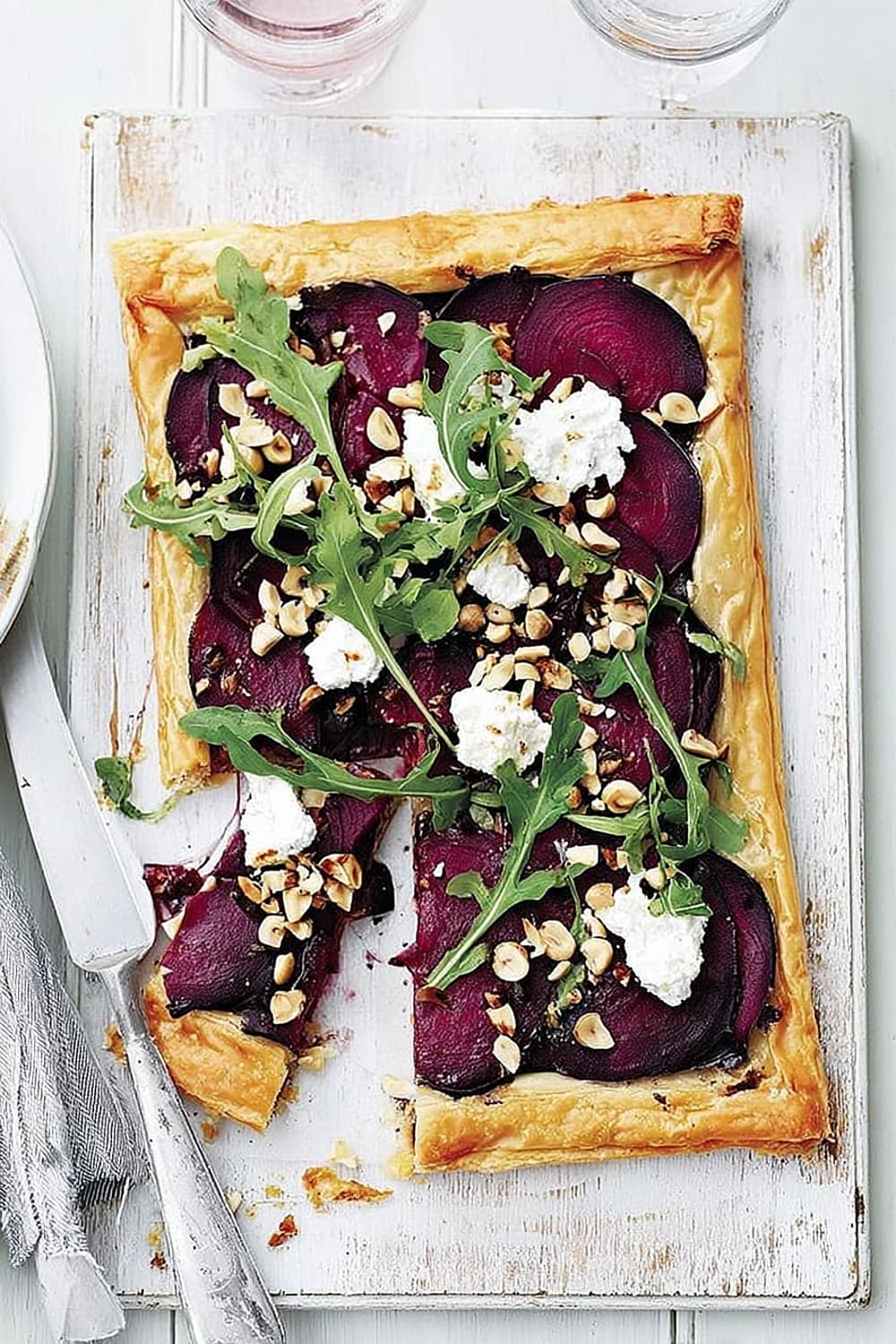
Make It Diabetes-Friendly
Sugar Substitutions:
- Replace 100ml honey with 50ml sugar-free honey alternative or 2 tablespoons erythritol mixed with 1 tablespoon water
- This reduces carbohydrates by approximately 20g per serving
- Stevia-based sweeteners work well but use sparingly as they’re much sweeter than honey
Flour & Carb Modifications:
- Replace puff pastry with almond flour pastry base or cauliflower crust to reduce carbs significantly
- Portobello mushroom caps can serve as individual tart bases for a virtually carb-free option
- These modifications reduce total carbohydrates from 18g to approximately 8g per serving
Portion & Timing Tips:
- Serve smaller portions (1/6 of tart instead of 1/4) alongside protein-rich salad
- Estimated carb content: 12-15g per modified serving when using sugar alternatives
- Pair with Greek yogurt or grilled chicken to balance blood sugar response
Total Carb Reduction: Modified version contains approximately 40% fewer carbohydrates than the original recipe
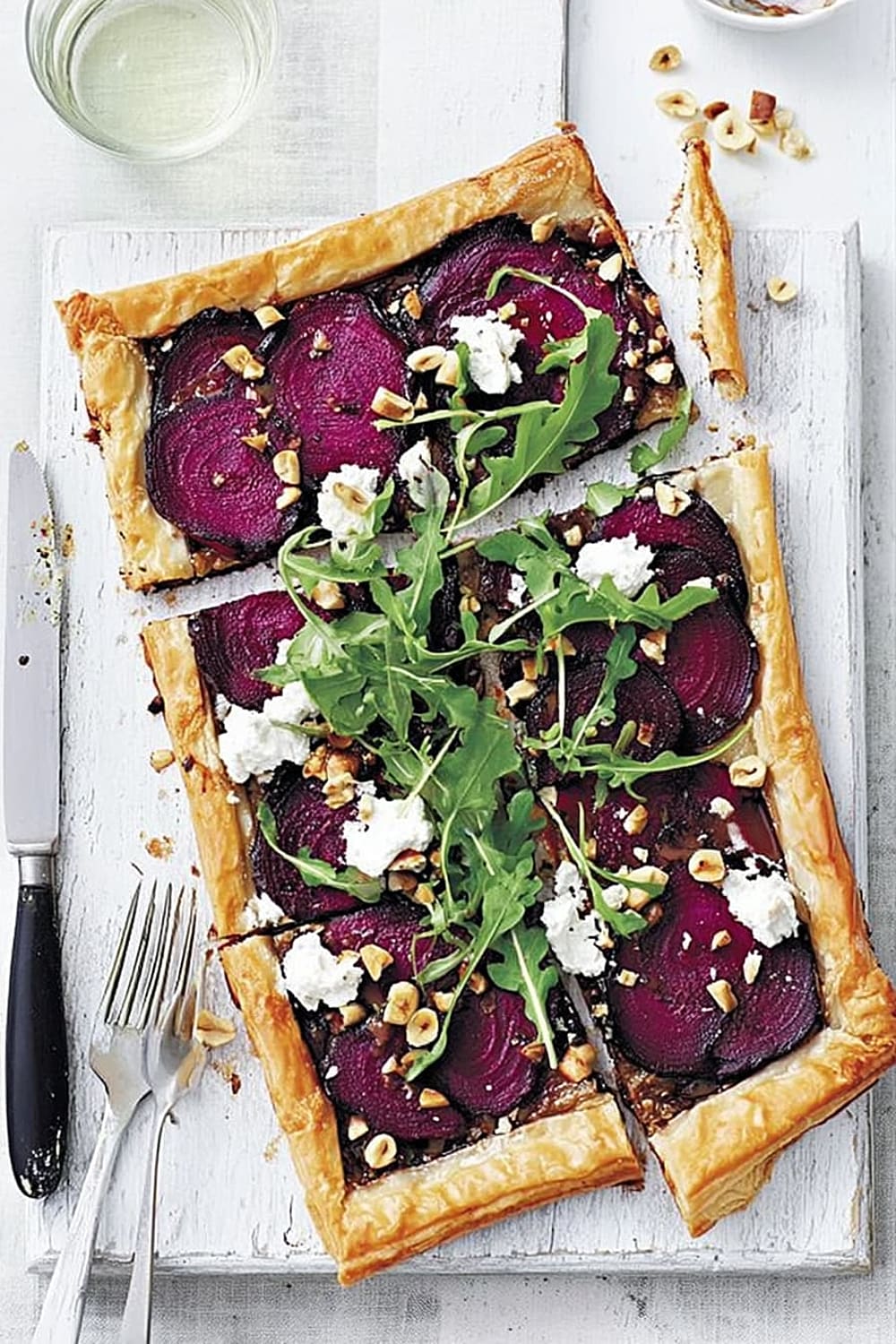
Perfect Pairing Suggestions
Beverage Pairings
A crisp Sauvignon Blanc or Pinot Grigio complements the earthy sweetness of the beetroot while cutting through the richness of the goat’s cheese. For red wine lovers, a light Pinot Noir works beautifully with the honey-roasted flavors. Sparkling elderflower cordial or ginger beer provides refreshing non-alcoholic options that enhance the tart’s natural sweetness.
Side Dish Recommendations
Serve alongside a mixed green salad with lemon vinaigrette to balance the tart’s richness. Roasted Brussels sprouts with bacon add complementary earthy flavors, while honey-glazed carrots echo the tart’s sweet notes. A quinoa tabbouleh provides protein and fresh herbs that pair wonderfully with the goat’s cheese.
Complete Meal Ideas
Start with butternut squash soup as an appetizer to continue the autumnal theme. Follow the tart with a dark chocolate mousse or poached pears for dessert. For casual entertaining, serve antipasti platters with olives, cured meats, and artisanal breads alongside the tart.
Occasion Suggestions
Perfect for autumn dinner parties, weekend brunches, or holiday entertaining. The vibrant colors make it ideal for Thanksgiving sides or Christmas vegetarian options. Excellent for picnics and potluck gatherings as it travels well and looks impressive.
Pro Tips and Troubleshooting
Professional Techniques
Score the pastry edges with a knife to create a decorative border that also helps prevent shrinkage. Blind baking the pastry for the first 10 minutes with baking beans ensures a crisp base that won’t become soggy from the beetroot juices. Pat the beetroot dry after roasting to remove excess moisture before arranging on the pastry.
Common Mistakes and Solutions
If the pastry puffs up too much during baking, prick it again with a fork and place a clean kitchen towel over it briefly. Soggy pastry can be prevented by ensuring the beetroot isn’t too wet and by pre-baking the pastry base. Burnt edges indicate the oven temperature is too high – reduce by 20°C and cover edges with foil.
Storage and Make-Ahead
This tart is best served fresh but can be stored in the refrigerator for up to 2 days. Reheat in a 180°C oven for 8-10 minutes to restore crispness. The beetroot can be roasted one day ahead and stored covered in the refrigerator. Assemble just before the final baking to maintain pastry texture.
Scaling and Presentation
Double the recipe easily by using two pastry sheets and adjusting ingredient quantities proportionally. Cut into elegant diamonds rather than squares for sophisticated presentation. Garnish with microgreens or edible flowers for special occasions.
This beetroot and goat’s cheese tart proves that impressive-looking dishes don’t require complicated techniques or exotic ingredients. With its perfect balance of sweet, savory, and creamy elements, it’s destined to become your go-to recipe for those moments when you want to create something beautiful and delicious without the stress.